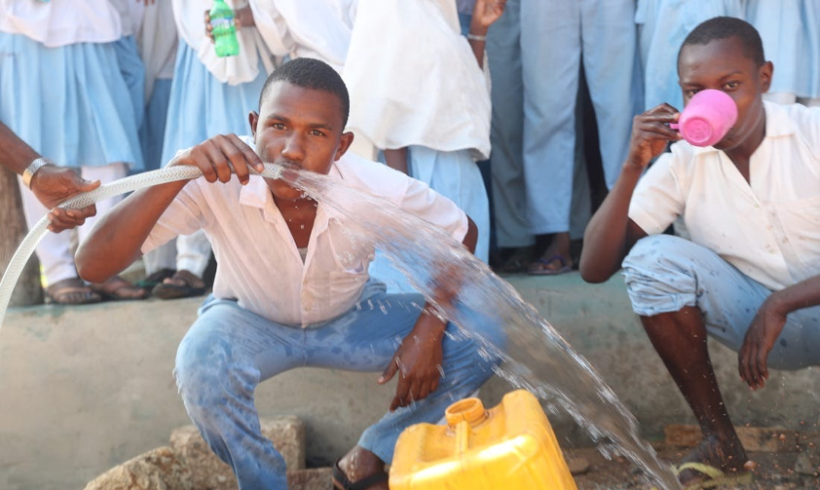 Matthew Capuano-Rizzo
Matthew Capuano-Rizzo
In May of 2019, GivePower installed solar power in Ciudad Perdida (“The Lost City”) in Northern Colombia. The power will support archeological and conservation efforts on the historic site.
GivePower is a nonprofit organization developed by Solarcity in 2013, a company acquired by Tesla in 2016. Givepower partners with corporate sponsors, many of them solar energy companies and green finance groups, to provide electricity through solar energy in seventeen countries and over 2,650 locations. Givepower’s first microgrid installation trek involved powering a school in El Islote, Nicaragua in 2014. In July of 2019, GivePower partnered with the Sioux Nation in Standing Rock to build the largest solar energy farm in North Dakota. Such an installation comes after a nation-wide mobilization of Native Americans and their supporters against the construction of the Dakota Access Pipeline in 2016. Their calls and appeals largely ignored by Washington DC, the pipeline began operation in 2017.
After Hurricane Maria devastated Puerto Rico in 2017, leaving 90% of Puerto Ricans without power, GivePower installed panels on a fire station to restore communication for emergency services. GivePower has also installed microgrids in Virunga National Park in the Democratic Republic of Congo to aid park rangers in their conservation efforts and facilitate the park’s mission of being a motor of sustainable development through tourism, electricity, agriculture and maybe even chocolate production. The organization has also employed solar power to expand economic opportunities in the fishing village of Mahji Goan and power a school and a clinic in Bagara, both in Nepal. Since 30% of Nepalese lack access to electricity, many are forced to leave their homes in search of better economic opportunities such as working in the coal mines that bring adverse health effects and destroy arable land. Microgrids allow people to live, work, study, and start businesses in their own homes. In a video of the project, one of the residents of Mahji Goan explained that “With solar, my future is in the village. I will return. I will bring my business home.”
Eduardo Lopez, GivePower’s Colombia Country Director, was born and raised in Colombia, but at the age of 14 left for the United States to continue his studies in boarding school, eventually studying economics as well as Environmental Thought and Practice at the University of Virginia. In an interview, he explained that his passion for the environment started at a young age. When he was 15, he attended the Island School in the Bahamas in which students learned biology through scuba diving in coral reefs and trigonometry through celestial navigation. The school’s campus is powered by wind and solar power and the school recycles rainwater and feeds livestock with food waste. During his summers at the University of Virginia, he interned at Groncol, a company that deploys green roof technology in Colombia’s capital city of Bogota.
That experience in addition to an internship at the Environmental Defense Fund led Lopez to understand that “you can’t just hold up a poster saying ‘Save the Polar Bears’ but you really have to make the economic case for it.” Instead of simply lamenting the many problems we face, Lopez has always been more interested in solutions. After a stint at the Colombian Ministry of the Environment in the Green Business sector, Lopez began working for GivePower. His first project was in Sierra Nevada de Santa Marta, a mountainous region in Northern Colombia. Communities, known as ‘campesinos’ had been pushed up the mountain during a period of conflict and were forced to travel down the mountain to sell plantains and cassava, often at very low prices. Partnering with a local nonprofit, Lopez and his team were able to implement a solar-powered machine to produce cotton. This project provided the ‘campesinos’ with a reliable source of income, as the partner organization was a guaranteed buyer. In his presentation, Eduardo Lopez, now Director of GivePower in Colombia, explained how the organization employs solar energy as an impact catalyst to improve peoples’ lives.
Impact sectors
GivePower focuses on seven impact sectors: water, food security, health, education, conservation, economic development and telecommunications. In his presentation Lopez emphasized that solar power is a means to an end. Education is difficult without access to the internet and completing homework assignments under the light of a kerosene lamp is not only challenging, but also dangerous. In the realm of health, Lopez mentioned the prospect of someone coming to a health clinic in the middle of the night for a baby delivery and the complicated nature of orchestrating such a procedure under candlelight. Similarly, many medicines such as snake bite antedotes in Colombia require refrigeration and life-saving medical devices such as defibrillators need electricity. To address issues of water security, Lopez explained how solar pumps can be live-changing as more two billion people live in countries with high water stress, a number that continues to rise with climate change. In addition, Lopez underscored climate change’s threat to food security and proposed GivePower‘s solution of creating aquaponic systems: a combination of fish (aquaculture) and hydroponics (plants). He explained how fish waste circulates through vegetable beds, providing nutrients to the crops, while the water comes out clean and can be recycled back into the system.
Many of the impact sectors intersect. For example, Lopez illustrated how providing access to telecommunications affords people the possibility of telemedicine as opposed to taking a taxing trip to the big city. If conservationists use a diesel generator to power their research, it “contradicts what people are going for in the conservation narrative,” Lopez affirmed. Thus, GivePower works with conservationists around the world to ensure that their systems are running sustainably with solar power. Lastly, solar facilitates economic empowerment by opening the possibility for new business models. Correspondingly, Lopez emphasized how this last goal ensures that solar systems are resilient. “Instead of depending on some entity to bring the fuel, they have ownership of their own system,” he stated proudly.
How is all of this possible?
GivePower has partners all over the United States, including businesses involved in providing inverters, panels, and wiring for the projects. Givepower’s corporate social responsibility program encourages participating businesses to send ten of their employees to the site to participate in the project’s implementation. Loanpal, a sustainability lender, allocates a portion of their profits to GivePower and the group sent several employees to La Guaripa in Colombia to participate in a project in October of 2019. Lopez explained that in looking around his home country of Colombia, there are many ‘elefantes blancos [white elephant projects]’ that have been abandoned. If organizations “only gift the pumping project, if something breaks, the community hasn’t been brought in and they don’t know how to fix it,” he clarified. To ensure that their projects are financially sustainable, GivePower often sells the water from solar pumps at affordable prices and trains community members on how to maintain the systems. According to Lopez, “if we give it away for free, we can’t replace the panels, we can’t replace the batteries.”
Such a system somewhat follows Nobel Prize winning economist Mohammad Yunus’ concept of social business. That is to say that a social business is conceived with a social mission, but unlike a charity that is in an ever-present search for funding, a social business aims to be financially self-sustaining, reinvesting profits back into generating greater impact. In the next part of his presentation, Eduardo Lopez dived into projects that he had supervised in Colombia.
All about empowerment
In May of 2019, GivePower installed a solar grid in Ciudad Perdida “the Lost City,” an abandoned city in the middle of the jungle in Northern Colombia designated by UNESCO as a World Heritage Site. A research station, located on the site was previously relying on diesel and a pelton wheel hydropower system for energy. According to Lopez, whenever it rained the water was so intense that the system shutdown and when it didn’t rain enough, the station lacked energy. Installing a microgrid in Ciudad Perdida thus provided researchers and park guards with reliable electricity. Another project in Colombia was orchestrated in the remote community of La Guaria located on the bank of the Orinoco river, the third largest river in the world. As the climate crisis intensifies, food insecurity will as well, particularly for communities that rely so heavily on fishing and agriculture. To avert this problem, Givepower worked with their aforementioned partner Loanpal as well as as the Orinoquia Foundation, a local non-profit, to install a microgrid and self-sustaining aquaponics system that will provide fish, vegetables, and refrigeration to the community.
When asked about womens’ empowerment, Lopez exclaimed “We love empowering women!” and illustrated his point through a story from GivePower’s Executive Director Barret Raftery. When Raftery sat down with the leaders of a particular community, they informed him that they did not really need energy. When pressed on if the community had many residents performing manual labor, the leaders replied that labor was not an issue either. All of those leaders were men. According to Lopez, Raftery then went to ask the children. The children of the community informed him that their mothers spent many hours each day retrieving water from the river and hand-grinding corn. Thus, installing corn huskers, mills, and water pumps all powered by solar panels allowed these women to have time to start taking classes and spend more time with their families. Lopez emphasized that research shows that micro-lending to women is more effective than micro-lending to men. He concluded by highlighting the importance of financial sustainability in projects to cover operation and maintenance. Countries have the ability to leap-frog technologies. “In most African countries, you can’t find landlines, but you can find cell-phones,” he explained. Instead of taking the time to dig up holes for landlines or set up fossil-fuel powered power grids, we can ‘leap-frog’ to cell phones and solar-powered micro-grids. Such ideas will be essential as we work toward a green recovery from the COVID-19 crisis. As we recover from the coronavirus pandemic, Lopez is looking to expand water projects. Maintaining proper sanitation techniques is understandably difficult without access to clean water. As demonstrated by organizations such as GivePower, cooperation across borders, languages, and backgrounds can allow us to move forward together with particular attention to the most vulnerable.
Photo: Residents in Kiunga, Kenya drink from GivePower’s desalination plant, powered by solar energy. The system creates 75,000 liters of fresh drinking water each day, enough for 25,000 people – GivePower/Business Insider



Leave a Reply